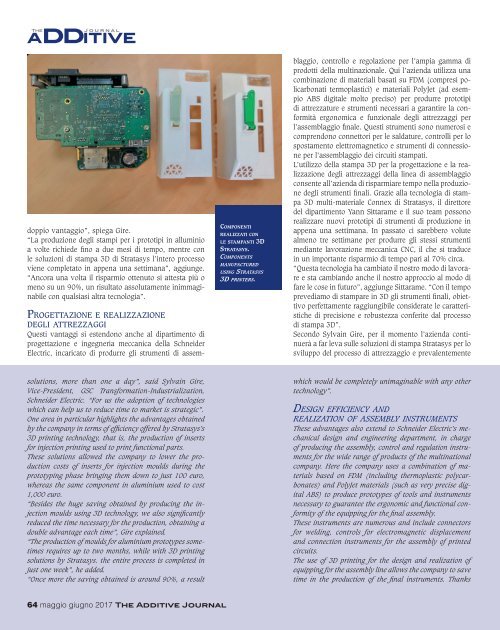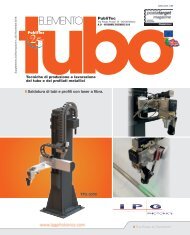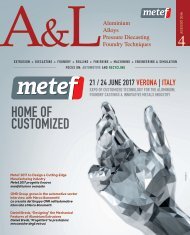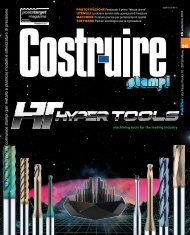Sfogliabile_Applicazioni_Laser_maggio_57
Create successful ePaper yourself
Turn your PDF publications into a flip-book with our unique Google optimized e-Paper software.
The<br />
Journal<br />
additive<br />
doppio vantaggio”, spiega Gire.<br />
“La produzione degli stampi per i prototipi in alluminio<br />
a volte richiede fino a due mesi di tempo, mentre con<br />
le soluzioni di stampa 3D di Stratasys l’intero processo<br />
viene completato in appena una settimana”, aggiunge.<br />
“Ancora una volta il risparmio ottenuto si attesta più o<br />
meno su un 90%, un risultato assolutamente inimmaginabile<br />
con qualsiasi altra tecnologia”.<br />
coMponenti<br />
realizzati con<br />
le StaMpanti 3d<br />
StrataSyS.<br />
componentS<br />
manufactured<br />
uSing StrataSyS<br />
3d printerS.<br />
Progettazione e realizzazione<br />
degli attrezzaggi<br />
Questi vantaggi si estendono anche al dipartimento di<br />
progettazione e ingegneria meccanica della Schneider<br />
Electric, incaricato di produrre gli strumenti di assemblaggio,<br />
controllo e regolazione per l’ampia gamma di<br />
prodotti della multinazionale. Qui l’azienda utilizza una<br />
combinazione di materiali basati su FDM (compresi policarbonati<br />
termoplastici) e materiali PolyJet (ad esempio<br />
ABS digitale molto preciso) per produrre prototipi<br />
di attrezzature e strumenti necessari a garantire la conformità<br />
ergonomica e funzionale degli attrezzaggi per<br />
l’assemblaggio finale. Questi strumenti sono numerosi e<br />
comprendono connettori per le saldature, controlli per lo<br />
spostamento elettromagnetico e strumenti di connessione<br />
per l’assemblaggio dei circuiti stampati.<br />
L’utilizzo della stampa 3D per la progettazione e la realizzazione<br />
degli attrezzaggi della linea di assemblaggio<br />
consente all’azienda di risparmiare tempo nella produzione<br />
degli strumenti finali. Grazie alla tecnologia di stampa<br />
3D multi-materiale Connex di Stratasys, il direttore<br />
del dipartimento Yann Sittarame e il suo team possono<br />
realizzare nuovi prototipi di strumenti di produzione in<br />
appena una settimana. In passato ci sarebbero volute<br />
almeno tre settimane per produrre gli stessi strumenti<br />
mediante lavorazione meccanica CNC, il che si traduce<br />
in un importante risparmio di tempo pari al 70% circa.<br />
“Questa tecnologia ha cambiato il nostro modo di lavorare<br />
e sta cambiando anche il nostro approccio al modo di<br />
fare le cose in futuro”, aggiunge Sittarame. “Con il tempo<br />
prevediamo di stampare in 3D gli strumenti finali, obiettivo<br />
perfettamente raggiungibile considerate le caratteristiche<br />
di precisione e robustezza conferite dal processo<br />
di stampa 3D”.<br />
Secondo Sylvain Gire, per il momento l’azienda continuerà<br />
a far leva sulle soluzioni di stampa Stratasys per lo<br />
sviluppo del processo di attrezzaggio e prevalentemente<br />
solutions, more than one a day”, said Sylvain Gire,<br />
Vice-President, GSC Transformation-Industrialization,<br />
Schneider Electric. “For us the adoption of technologies<br />
which can help us to reduce time to market is strategic”.<br />
One area in particular highlights the advantages obtained<br />
by the company in terms of efficiency offered by Stratasys’s<br />
3D printing technology, that is, the production of inserts<br />
for injection printing used to print functional parts.<br />
These solutions allowed the company to lower the production<br />
costs of inserts for injection moulds during the<br />
prototyping phase bringing them down to just 100 euro,<br />
whereas the same component in aluminium used to cost<br />
1,000 euro.<br />
“Besides the huge saving obtained by producing the injection<br />
moulds using 3D technology, we also significantly<br />
reduced the time necessary for the production, obtaining a<br />
double advantage each time”, Gire explained.<br />
“The production of moulds for aluminium prototypes sometimes<br />
requires up to two months, while with 3D printing<br />
solutions by Stratasys. the entire process is completed in<br />
just one week”, he added.<br />
“Once more the saving obtained is around 90%, a result<br />
which would be completely unimaginable with any other<br />
technology”.<br />
DesiGn efficiency anD<br />
realization of assembly instruments<br />
These advantages also extend to Schneider Electric’s mechanical<br />
design and engineering department, in charge<br />
of producing the assembly, control and regulation instruments<br />
for the wide range of products of the multinational<br />
company. Here the company uses a combination of materials<br />
based on FDM (including thermoplastic polycarbonates)<br />
and PolyJet materials (such as very precise digital<br />
ABS) to produce prototypes of tools and instruments<br />
necessary to guarantee the ergonomic and functional conformity<br />
of the equipping for the final assembly.<br />
These instruments are numerous and include connectors<br />
for welding, controls for electromagnetic displacement<br />
and connection instruments for the assembly of printed<br />
circuits.<br />
The use of 3D printing for the design and realization of<br />
equipping for the assembly line allows the company to save<br />
time in the production of the final instruments. Thanks<br />
64 <strong>maggio</strong> giugno 2017 The Additive Journal





